Consider this: Approximately 92% of the top prescribed medicines come from plants or fungi.1 Many medications are plant-based, and there are numerous medicinal plants whose benefits we haven’t even studied yet.
Learning about medicinal plants can decrease your dependency on the pharmaceutical industry, improve self-reliance, and possibly save your life when traditional medicines aren’t available.
There are too many medicinal plants to talk about them all here. If you want to learn natural medicine, Rosemary Gladstar’s Medicinal Herbs book (Amazon Link) is a great place to begin.
In this post, I want to focus on a specific subset of medicinal plants: natural antiseptic plants. These plants can be used as a “natural Neosporin” for treating wounds and preventing infection.
An infection might not seem like a big deal, but it can lead to deadly sepsis.
When Small Wounds Become Deadly
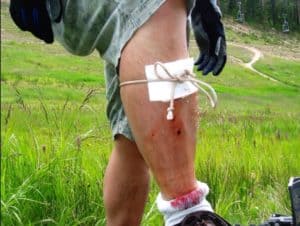
Before we get into the top natural antibacterial plants, we must understand why antibacterial salves are important, especially in backcountry or survival situations.
When you get wounded, the body reacts by releasing white blood cells into the area. They cause the wounded area to become inflamed and form blood clots with platelets, so the wound is sealed off from the rest of the body.
Minor wounds usually tend to heal on their own. However, this largely depends on whether you can keep the wound clean. If it gets dirty, infection inevitably occurs (as you’ve probably seen when an injury starts to ooze puss).
If the infection isn’t treated quickly, the body can’t contain it. The inflamed blood vessels leak, releasing infection-fighting chemicals into the blood.
The result is sepsis, an inflammatory condition in which the body attacks itself.
Dangers of Sepsis
The inflammation that occurs during sepsis prevents blood from flowing throughout the body. The blood pressure drop can become so drastic that it prevents nutrients from getting to organs. Without prompt intervention, organ failure can occur.
Septic shock occurs quickly and can be fatal. This is why it is essential to treat wounds – even minor wounds – with antiseptic ointments and keep them clean.
Symptoms of Sepsis
High body temperature
Rapid heartbeat
Shortness of breath
Shivering
Extreme pain
Pale skin
Lethargy
Diarrhea
Nausea
Risk of Sepsis
In unsanitary conditions – such as in the backcountry or after a natural disaster like flooding – wounds are easily exposed to harmful pathogens.
After virtually every natural disaster, we inevitably see an increase in skin infections and sepsis. For example, after the 2017 flooding of Houston, there was a surge in skin infections. Some of these developed into life-threatening sepsis.
Luckily, no one died from sepsis after the Houston flooding. Most cases of skin infections were easily treated with antibiotics at the hospital.
We might not always have access to antibiotics or medicines in the aftermath of a disaster, though, which is why it is so important to know how to treat wounds and make your natural remedies from plants.2, 3, 4
How to Treat Wounds
One of the essential first aid skills you need is how to treat a wound. It is also vital you have everything in this first aid supplies checklist in your home.
In a disaster situation, you could improvise dressing or quickly make an antibiotic salve – but it is better to be prepared than have to start gathering wild medicinal plants while your loved one is bleeding!
You can read more details about how to treat wounds when medical help isn’t available in this post. Here are the basic steps:
- Clean Hands – You must wear nitrate gloves or thoroughly clean your hands. You don’t want bacteria from your hands getting into the wound.
- Control Bleeding – Apply pressure to the wound until blood flow stops. Only once bleeding has stopped should you proceed. It helps to know the difference between venous and arterial bleeding for this step.
- Clean the Wound – You’ll need tools like tweezers, q-tips, sterile cotton balls, and a syringe with sterile water to clean the wound. In backcountry situations where these aren’t available, pour significant amounts of sterile (boiled) water over the wound to clean it.
- Apply antibiotic ointment – Now is the time to utilize those natural antiseptic plants. The ointment also prevents gauze from sticking to the wound. This is important; otherwise, you’ll rip off all the newly formed skin cells each time you change the gauze.
- Cover with gauze/sterile dressing – You can use cling wrap instead of gauze for treating burns.
- Change dressings regularly – Dressings need to be changed approximately twice per day. When changing the dressing, monitor the wound for any signs of infection.
Top Herbs And Plants For Treating Wounds
Because there are so many medicinal plants that have natural antiseptic properties, here we will focus on plants and herbs which are:
- Found in North America
- Effective for natural wound healing
- Backed by scientific evidence
Goldenseal (Hydrastis Canadensis)

Goldenseal is a well-known natural antibacterial. The main active compound is berberine. It has been tested against antibiotics like penicillin and is a suitable natural alternative. Goldenseal also has numerous other benefits, such as fighting diabetes and tumors.
The plant is usually sold as an oral formation, but you can also use it topically to treat wounds, pink eye, canker sores, and vaginal infections. Please note that Goldenseal has endangered status – you aren’t supposed to pick it on public lands without a permit!
Maybe consider planting some in your medicinal garden.
- Where Found: Northeastern USA.
- How to Use for Wound Treatment: The most potent part of the plant is the roots. Cut these up, dry them, and use them for making tinctures or oil infusions. 5, 6
Alder (Betulaceae Alnus)

Alder is a nut-bearing shrub. Its bark contains the natural anti-inflammatory agent salicin. Native Americans used it to treat poison oak, ivy, and other itchy skin conditions.
The tannins in alder are potent natural antibacterial agents. The plant is also rich in antioxidant phenols and flavonoids. It is great for treating wounds and as a natural pain reliever.
- Where Found: Widely found throughout North America, Europe, and Asia
- How to Use: Collect the alder plant’s twigs, bark, or leaves. These can be steeped into an oil infusion, cooked into a resin, or made into a tincture.7
Coniferous Tree Sap (Spruce, Pine, Fir, etc.)

Coniferous trees release a sticky sap when their bark is damaged. The sap contains various natural acids and lignans, which protect the tree from infection. These very same compounds can also protect humans from infections.
Resins have long been used for treating wounds naturally. They have been highly studied and have a very low incidence of allergic reactions.
- Where Found: Northern hemisphere and mountainous regions of the south
- How to Collect Tree Resin: You’ll need to make a V-shaped notch on the tree trunk. You’ll put a collection device below the point of the V to catch the sap. Read more about how to tap trees.
- How to Use for Wound Treatment: Traditionally, the tree resin is heated and mixed with unsalted butter to make a salve. You can also mix it with other oil, such as olive oil or coconut oil. You shouldn’t apply resin directly to a wound, though it is too sticky and will make changing bandages difficult. 8, 9
Wild Comfrey (Cynoglossum virginianum)

The type of comfrey native to North America is known as “wild comfrey.” It’s easy to confuse wild comfrey with its cousin, Common comfrey (Symphytum officinale), especially since they are both tremendous medicinal plants for healing wounds.
Wild comfrey is an antioxidant, natural pain reliever, and anti-inflammatory. Be careful not to confuse it with foxglove, as that plant could result in poisoning.
- Where Found: Mostly around Kentucky, it can also be found in some deciduous forests.
- How to Use for Wound Treatment: Harvest the roots and leaves to make a tincture or infused oil. When in a hurry, you can grind up leaves to create a poultice to apply to wounds. 10, 11, 12
Calendula
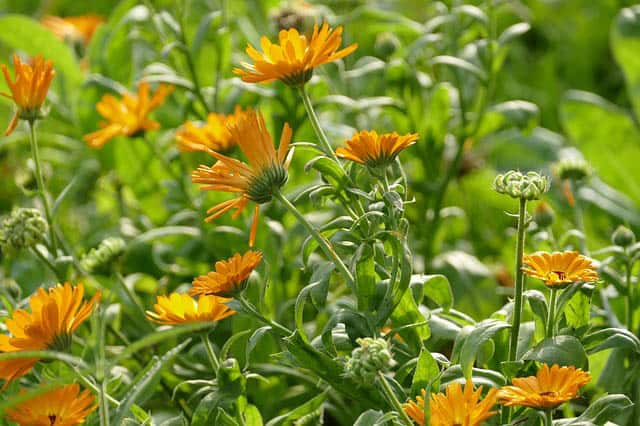
Better known as marigold, this genus of plants includes many species, all of which are medicinal plants. It has been highly studied against various types of bacteria. Other studies have shown it is effective against fungal infections as well.
One study looked specifically at wound healing. It found that calendula is antibacterial, anti-inflammatory, helps form new blood vessels and aids in forming fibrous tissues.
- Where Found: Calendula is native to Europe and Eurasia; it is commonly cultivated in gardens in North America.
- How to Use for Wound Treatment: The petals contain the most active ingredients. Studies have found much better results with the petals than other parts of the plant. 13
Plantain (Plantago major)

Plantain is an edible plant that can probably be found in your backyard right now.
Besides being nutritious (even if not very tasty), it contains the active compounds aucubin and allatonin. These compounds are responsible for plantain’s antimicrobial and anti-inflammatory properties.
Plantain is also suitable for ulcers, indigestion, heartburn, insect bites, diarrhea, and colds.
- Where Found: Plantain can be found worldwide, including in cities. It is often considered a weed.
- How to Use for Treating Wounds: Collect just the leaves of the plants to make tinctures or salves. Choose older leaves for medicinal purposes. The younger leaves have fewer medicinal compounds but are more tender and better for eating.14
Wild Garlic (Allium)
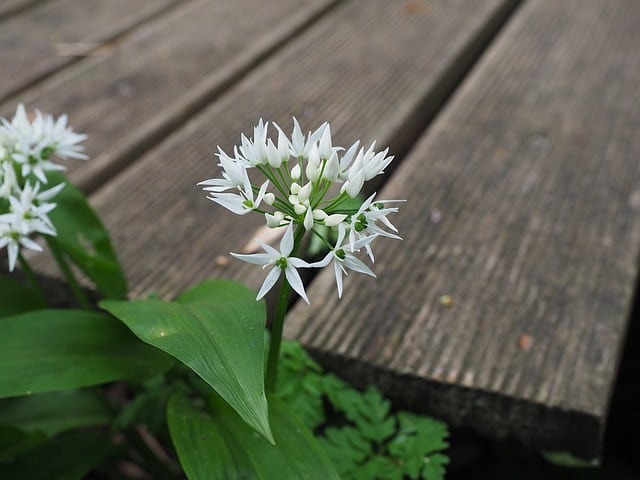
Wild garlic has been used as a natural remedy for infections for centuries. Many (including my grandmother) recommend swallowing entire garlic cloves to fight off colds and flu.
The scientific literature supports garlic’s role as a natural antibacterial medicinal plant. When a garlic bulb is cut, it releases a potent antimicrobial called allicin for preventing infections. Allicin is why garlic only starts to smell after you cut it.
- Where Found: Wild garlic is primarily found in the eastern part of the United States. The garlic you buy in the store also has medicinal properties.
- How to Use for Treating Wounds: It is best to make an infused oil salve or tincture out of garlic. However, you can also use fresh garlic for treating wounds. Grate up garlic and mix it with water to make a paste. Apply this paste to a sterile bandage. Apply a new paste each time you change the bandage. 15
Lavender (Lavendula)
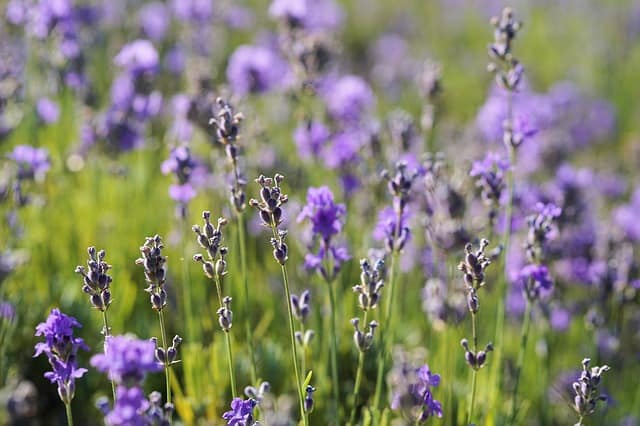
Lavender is best known for its scent but is also a natural antibacterial. One study tested it against 31 strains of bacteria, yeasts, and molds and found it potent. The compounds linalool and ramarinic acid in lavender are likely responsible for the antibacterial benefits.
Another benefit of lavender is that it is easy to find throughout almost all of the United States. Lavender is a hearty bush; you can quickly grow it in your garden.
- Where Found: Lavender is native to the Mediterranean region. It is found throughout the USA.
- How to Use for Treating Wounds: Use the flowers and stalks to make an infused oil salve or tincture.16
Learn how to make lavender oil at home or buy it online.
Oregano (Origanum vulgare)

Oregano has gotten a lot of attention recently as a natural antibiotic. In one study that tested oregano oil against over a dozen different bacteria, oregano possessed a more potent antimicrobial activity than antibiotics.
Topically, oregano oil has been shown to reduce infection, help wounds heal, and reduce the appearance of scars.
- Where Found: Oregano and its subspecies can be found throughout the world. It is easy to confuse with other plants, so smell the plant to identify it correctly.
- How to Use for Treating Wounds: Use just the plant’s leaves to make an infused oil salve or tincture. 17, 18
Learn how to make oregano oil at home or buy it online.
Yarrow (Achillea millefolium)
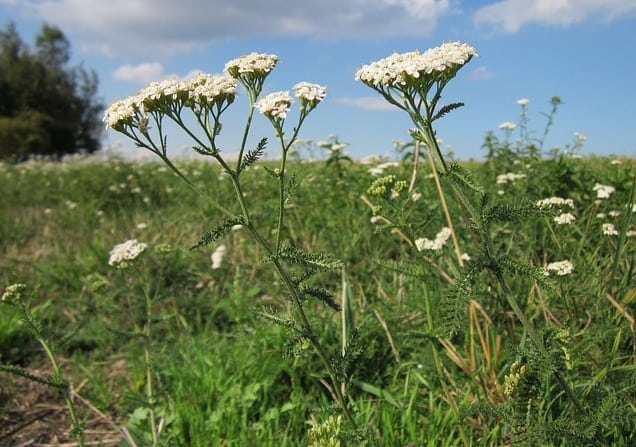
The name Achillea comes from Achilles, who was said to carry it with him to treat his soldiers’ wounds during the Trojan war. Indeed, there are many folk stories about yarrow, and it has been used for a long time as a natural wound healer.
Yarrow is ideal for healing wounds naturally because it contains volatile oils that reduce inflammation and fight infection. Research has found it effective against various strains of staph bacteria. The salicylic acid in yarrow can even help stop bleeding.
Test a small amount of yarrow on your skin before applying it to a wound. Though rare, some people have severe allergic reactions to yarrow.
Do not give yarrow to pets. It is toxic to dogs, cats, and horses.
- Where Found: Yarrow is found in temperate zones in North America, Europe, and Asia.
- How to Use for Treating Wounds: Harvest the leaves and flowering top of the plant for medicinal use. It is best to dry and make it into an infused oil salve or tincture. However, you can also grind up fresh yarrow with water to make a paste and apply it directly to wounds. 19, 20
Learn how to make yarrow oil at home or buy it online.
Chickweed (Stellaria media)

Considered a weed, chickweed is one of the most overlooked medicinal plants for healing wounds. It has strong anti-inflammatory properties and is excellent for treating skin conditions like eczema. As for wounds, chickweed’s antimicrobial properties make it ideal for cuts and burns. Studies have even found that chickweed is effective against hepatitis B, so don’t take this weed for granted.
- Where Found: Native to Europe, chickweed can be found throughout North America. Note that chickweed is very similar to plants in the Cerastium genus. True chickweed will have fine white hairs on the stems, which grow in a weave-like pattern. Cerastium has evenly distributed hairs on the branches.
- How to Use for Treating Wounds: Usually, the leaves, stalks, and flowers of chickweed are used. The seeds and roots also have medicinal properties, though. Make it into an infused oil salve or tincture. 21
Suggested Reading
-
-
 Check on Amazon
Check on AmazonIn addition to medicinal plants that you’ll be able to forage locally, there are also many remedies from foods in your cupboards, like coffee and culinary spices. The photographic index is a nice touch.
-
 Check on Amazon
Check on AmazonFor those who want to learn about medicinal plants growing throughout the United States. It features over 1,000 herbs and 1,500+ photos.
-
 Check on Amazon
Check on AmazonThough a bit dated this is still one of the best guides on turning plants into medicine. It includes detailed instructions on how to make infusions, decoctions, distillations, essences, and tinctures. Available for Kindle as well.
-
 Check on Amazon
Check on AmazonA good read for those who want to make DIY home remedies for everything from hay fever to razor burn. There are lots of great photos and recipes as well.






















Is distilled water sterile and is it suitable for irrigating a wound?
Yes distilled water is sterile and would be suitable for cleaning a wound in a situation where no proper medical help is available.
Whether or not water is sterile depends on a lot of factors actually; when in doubt boil.
Remember that distilled water that was clean may not be clean now. Many containers are not as impermeable as they seem; plastic degrades and over time can’t be relied upon to keep water safe.
The conditions under which the water was stored originally matter too — if you can’t guarantee sterile water at the time of bottling, it isn’t sterile. Was absolutely everything that touched that water sterile?
In survival there are no absolutes. Every situation is unique and while we know things to be generally true, you also have to consider your current situation.
When in doubt, boil. The heat of the water will sterilize it, and the heat of the vessel it’s boiled in will generally sterilize the vessel. Don’t let the water touch anything else and your chances at that point are pretty good.
We minimize chances of contamination. Short of a clean room, we can’t ever guarantee them.
Speaking of, no one bothers to mention that plants often carry their own dangerous contaminants. Your calendula might be a great anti microbial in and of itself but where did you collect it? How did you clean it? Herbs aren’t magic; they’re plants. Is your tincture jar sterile? How many times have you put your unwashed hands on it, in it?
No guarantees. Always take each situation independently and assess your risks situation by situation, moment by moment. Be present, observant, don’t act on rote. Use common sense.
Thank you – I’m finding your website fascinating. 🙂